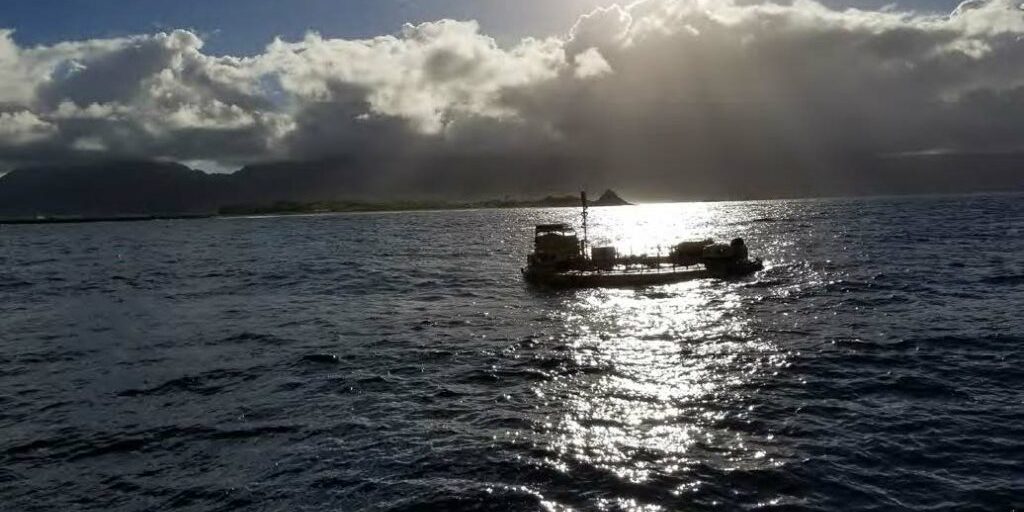Humankind has extracted energy from the sea throughout civilized history. For millennia, the sea’s currents and winds have pushed ships and filled sails to provide transportation. For centuries, the sea’s role as a heat sink and moisture source has provided the wind and precipitation patterns that spin windmills and water wheels, providing mechanical work. Presently, researchers are exploring the sea’s ability to generate the energetic currency of our generation: electricity.
Extracting power directly from the ocean makes a lot of sense considering its forceful waves, currents, tides and vast surface area for thermal absorption. The ocean also comprises 71 percent of the Earth’s surface, and as such, should not be lightly brushed aside in the search for a sustainable energy strategy. According to the National Oceanic and Atmospheric Association, 39 percent of the
U.S. population lives in a coastal county, and this population is expected to increase over the coming decade. Combined with the observation that coastal states have higher average electricity prices nationwide, the case for ocean power continues to build. [1] The U.S. Department of Energy estimates that the ocean has a theoretical capacity of more than 2,100 terawatt-hours of electricity per year, which is more than half the 4,000 terawatt hours of annual domestic consumption. [2]
Using the ocean for energy generation is not new; the first patent for wave power extraction was filed in 1799 by Frenchman Monsieur Girard and his son. This device was designed to use direct mechanical action to drive tools such as pumps or rotary machines. Interest waned over the following centuries as ample supplies of hydrocarbons reduced the drive for ocean energy research. This trend reversed sharply during the 1970s oil crisis, and marine energy conversion became a hot topic in a population jarred by the realization fossil energy will not always be cheap and abundant. [3]
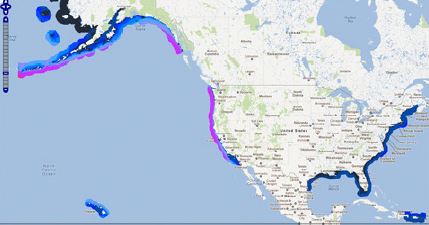
A color-coded map showing the recoverable wave and tidal resourcesfor the costal areas. The Electrical Power Research Institute estimates the recoverable amount of energy is 1,170 TWh/yr. (Courtesy of the National Renewable Energy Laboratory/Released)
Ocean waves are formed by winds over the course of lengthy fetches and travel long distances with very low energy losses. Therefore, when waves reach the shore, they represent the integration of wind energy from vast areas over a period of many days. This gives wave energy the comparative advantage of consistency over resources such as wind or solar. Consistency is an important factor when integrating a resource into the grid, and its value is reflected by the cost of reserve generation needed to compensate for lulls in generation. [4] With wave power, the inevitable flat days can be predicted at least a week or more in advance by offshore buoys that detect swell direction, amplitude and
period, giving the utility time to prepare energy reserves.
The technologies
There are four main types of wave energy converters: attenuators, point absorbers, overtopping devices and terminators. [3,5]
The attenuator is a multi-jointed series of floating segments with its primary axis aligned perpendicularly to the oncoming wave front. Attenuators are built with lengths comparable to, or greater than, the wavelength so the floating segments move up and down with respect to each other as the wave propagates beneath. The energy is extracted at the moving joints by hydraulic or other mechanisms. The first appreciable-sized wave farm was an attenuator-type deployed in Portugal. [6] The devices resembled massive, bobbing,
segmented worms on the water.
Point absorbers rely on motion along the vertical axis without respect to the wave direction. A large number of wave energy converters fall into this category. The conceptually simplest design features an inertial linear generator inside a buoy; but point absorber designs vary greatly in their level of sophistication. For example, oscillating water columns use vertical water movement to drive air through a piston or Wells turbine for energy conversion. These water columns can be implemented in buoys or on shoremounted
installations. [7]
For shallower depths, floor-mounted point absorbers become practical. In one such implementation, a generator is placed on the ocean floor and driven by a bobbing buoy. [8] A floor-mounted generator is also possible without a floating element. In this variant, modulating fluid pressure from the surface waves is picked up by the device and converted to electrical energy. [9] This latter example has particular appeal since it is the least obtrusive to navigation and aesthetics; however, serviceability could be a particular challenge.
It is perhaps the periodic miniature waterfalls occurring between each wave on rocky seashores that inspired overtopping devices for
wave energy conversion. These designs direct water flow such that the splash over from wave crests is guided to the mouth of a turbine to feed a generator-connected turbine.
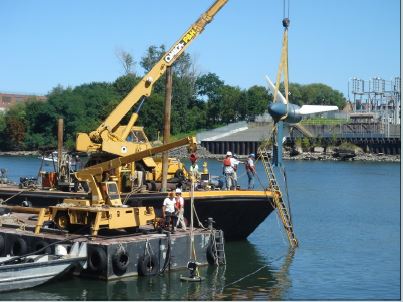
Columbine Power deployed an intermediate-scale prototype point absorber, code named SeaRay near Seattle, Wash. to conduct sea trials. (Photo by Columbia Power Technologies, courtesy of NREL/Released)
Terminators are wave energy converters with high extraction factors that can leave a visible wake of flatness behind them. The socalled Salter’s Duck, invented at the University of Edinburgh in the 1970s, is the best-known example of a terminator. It is a teardropshaped rotary float that extracts energy from waves with proportionally-sized wavelengths when aligned appropriately. Although the duck’s research was stalled after the 1970s, renewed interest has been found recently with optimized designs. [10]
Currents represent another source of kinetic energy that can be extracted from the ocean. This steady water movement can arise from a surprising number of factors, including tides, wind stress, gradients in temperature/pressure/solute concentration, river effusion, the Coriolis Effect and/or bathymetry. Analysis from Georgia Tech concluded that the Gulf Stream system from Florida to North Carolina within 200 miles of the coastline dissipates an average of 163 terawatt-hours per year. [11] Tides, which create the most predictable currents, can be harnessed in regions where water channels are long and narrow for increased water velocities. Alaska has the highest number of these regions, with the Cook Inlet representing the flagship location for large area tidal stream power density. Although implementations vary significantly, tidal power extraction is typically performed by a fixed, submerged turbine.
Ocean waves and currents are a source of kinetic energy, but the sea also stores massive amounts of thermal energy. This is the basis of Ocean Thermal Energy Conversion, which exploits the temperature gradient between deep and shallow waters. OTEC is most feasible in tropical waters with sufficient depth (typically over half kilometer) to achieve a temperature delta substantial enough to run a Rankine engine. OTEC plants can employ open-cycle or closed-cycle designs. Open-cycle plants utilize vacuum-assistance to vaporize warm seawater into steam that drives a turbine. This steam is then condensed by cold water pumped from below. Closed-system OTEC plants use an intermediary heat exchanger and a working fluid such as ammonia or carbon dioxide. Most closed-cycle designs to date also employ a cold water pipe and pumping system, but a recent design utilizes existing pressure differentials to eliminate the need for that expensive component. [12]
The challenges
The current maturity level of ocean energy conversion is low compared to other forms of renewable energy. One reason for this is a lack of convergence across the broad spectrum of nascent technologies, which is evident from the diverse sampling of technologies listed so far. [2] Some argue a diversity of generating technologies is the best method to capture energy from diverse conditions; however, at the same time, the lack of industrial focus is a challenge for a technology that needs significant capital outlay to conduct meaningful pilot projects.
Ocean energy conversion faces a host of unique challenges that will likely continue to burden the technology’s adoption. Often, these problems lie within the engineering domain. For example, the devices must be capable of weathering the 20, 50 or 100–year storms that are likely to arise across its expected lifespan. The Verdant Power installation in the New York East River suffered turbine damage in 2006 from unexpectedly swift currents, exemplifying the need for an extra degree of structural robustness in aqueous environments. [13] Even in calm seas, the ocean presents a very harsh environment for machinery. Salt corrosion must be mitigated, and material choice plays a big part in addressing that. Biofouling is a big concern for all ocean-faring systems. It is critical to avoid even microscopically thin layers of microbial build up on heat exchangers on OTEC devices because they can interfere with the transfer of heat, reducing efficiency. [14] As with corrosion resistance, material choice helps with biofouling. Bioresistant coatings that do not leach toxic chemicals into the surrounding environment, which had previously been a concern, have been recently formulated. [15] In all cases, regular maintenance is the key.
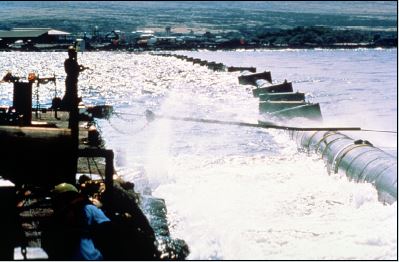
Laying of the cold water pipe at Keahole Point, Hawaii. The pipe supplies the cold water for the OTEC experiment at Hawaii’s Natural Energy Lab (Photo by A. Resnick, courtesy of NREL/Released)
Offshore wind is an unsurprising vanguard in the field of ocean-based generation because much of the technology matured on land before moving to the ocean for its long uninterrupted fetch and cheap real estate. Ocean energy conversion does not enjoy the benefit of starting on the shoulders of land-based technology like offshore wind. However, looking to technologies that adapted wind from a landlocked capability to an offshore one can solve many of the general-case challenges ocean energy conversion faces. Inexpensive underwater transmission infrastructure is one. Another is operation, maintenance techniques and equipment that can quickly, cheaply and safely service deployed installations.
In some sense, engineering challenges are easier to tackle than social and environmental challenges. As a shared resource, the sea is utilized by energy interests, militaries, fishermen, merchant shipping and tourists. Energy installations can affect visibility above the sea surface and acoustic behavior below. If not charted, floating devices can damage (or be damaged by) vessels, and anchored devices can be destroyed by trawling or dredging. In many cases, the very coastal features that make tidal estuaries attractive for energy extraction also make them attractive for shipping lanes, creating a sharp spatial conflict.
It is ironic that the environmental motivation for pursuing ocean energy extraction butts against the conflicting environmental motivation of keeping the sea unblemished by machinery. Aesthetic impacts are a matter of social preference, mirroring the debate over whether wind turbines are elegant landmarks of towering white or intrusive eyesores of industrial sprawl. While effects to native fauna are objective concerns, artificial noise emitted from devices is a potential concern to animal navigation or communication, but these effects are not yet well understood. The potential for mechanical movement of turbine blades to wound or kill fish has been studied for certain classes of turbines and fish. Because of the primarily low speed and cross-sectional profile at which hydrokinetic turbines typically operate, fish damage was determined to be a small concern in one flume-based study. [16] However, new studies must continually be conducted as turbine designs evolve.
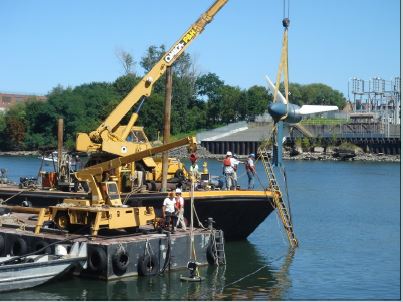
Verdant testing its tidal energy device in New York’s East River.(Photo courtesy of Verdant Power/Released)
Despite the challenges associated with ocean energy conversion, the ocean’s sheer capacity for energy capture indicates that all of these engineering and social challenges are worth solving. Ocean energy conversion has been deemed cost competitive in some situations, even at its early stage of technology readiness and dilute energy density. A very recent study shows that in the Pacific Northwest, wave energy conversion already tops wind energy for expected cost-competitiveness within the local balancing authority. [17]
As an interesting side note, ocean energy conversion is in a particularly intriguing position with respect to climate change. On the one hand, it works to reduce carbon emissions by offsetting fossil fuel combustion, but ocean energy conversion is also well positioned to enjoy the benefits of a higher mean global temperature. Warmer waters could enable higher thermal extraction potential, and higher offshore storm frequency could allow for more wave generation.
There is no doubt, after surveying the diversity of technical approaches being pursued, these are exciting times for wave, current and ocean thermal energy conversion. In accordance with the “all options on the table” approach to sustainably meeting the world’s energy needs, the field of ocean energy conversion by itself represents a diverse set of options in renewable energy generation.
References:
[1] Zayas, J. (2010, July 20). DoE offshore wind program overview [PDF file]. United States Department of Energy Wind and Water Power Program.
[2] U.S. Department of Energy Wind And Water Power, Wind and Water Power Technologies Office. (2013, January). U.S. Department of Energy Wind and Water Power Technologies Office Funding in The United States: Marine and Hydrokinetic Energy Projects Fiscal Years 2008 – 2012. (DOE/EE-0710).
[3] Drew, B., Plummer, A., & Sahinkaya, M. (2009). A Review Of Wave Energy Converter Technology. Journal of Power and Energy, (223) pp. 887-902.
[4] Wave energy costs should compare favorably to other energy sources. (2015, January 7).
[5] Bureau of Ocean Energy Management.
[6] Bureau of Ocean Energy Management.
[7] Rohling, G. (2007). Tapping the Sun and Moon [PDF file].
[8] Seabased A.B.
[9] M3Wave.
[10] Maramara, R. (2014). Jellyfish and GreenHarbor—lowest cost per KW ocean wave harvester. Poster session at the Austin Defense Energy Summit, Austin, TX.
[11] Haas, K. A., Fritz, H. M., French, S. P., & Neary, V. S. (2013, September 15). Assessment of Energy Production Potential from Ocean Currents Along the United States Coastline. Georgia Tech Research Corporation final project report to Wind & Water Power Program, Office of Energy Efficiency and Renewable Energy of the U.S. Department of Energy under Contract No. DEEE0002661.
[12] Lau, J. C. (2013). U.S. Patent No. 8484972.
[13] Marine and Hydrokinetic Energy Technology Assessment Committee; Board on Energy and Environmental Systems; Division on Engineering and Physical Sciences; Ocean Studies Board; Division on Earth and Life Sciences; & National Research Council. (2013). An Evaluation of the U.S. Department of Energy’s Marine and Hydrokinetic Resource Assessments. The National Academies Press.
[14] Gerchakov, S. M., Marszalek, D. S., Sallman, F. B., & Udey, L. R. (1977). Observations on Microfouling Applicable to OTEC Systems. OTEC Biofouling and Corrosion Symposium.
[15] Zhang, Z., Loose, C., Smith, R., Ashman, M., Rushford, L., & Berkenwald, A. (2012). Environmentally Benign and Permanent Modifications to Prevent Biofouling on Marine and Hydrokinetic Devices. Semprus BioSciences Report to Department of Energy Office of Energy Efficiency and Renewable Energy Wind & Water Power Program.
[16] Electric Power Research Institute (2012). Environmental Effects of Hydrokinetic Turbines on Fish: Desktop and Laboratory Flume Studies.
[17] Parkinson, S. C., Dragoon, K., Reikard, G., Garcia-Medina, G., Özkan-Haller, H. T., & Brekken, T. K. A. (2015). Integrating ocean wave energy at large-scales: A study of the US Pacific Northwest. Renewable Energy (76) pp. 551–559.


